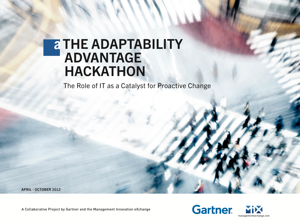Building an Adaptability Advantage: Takeaways from the Gartner Hackathon
Exploring the Role of IT as a Catalyst for Proactive Change
In March at the Phoenix CIO Leadership Forum, Polly LaBarre kicked off The Adaptability Advantage Hackathon, a joint initiative between Gartner EXP and the Management Innovation eXchange (MIX). Working together, Gartner and the MIX invited a select group of IT leaders to crack a key issue:
How can IT help organizations become more adaptable?
Gary Hamel set up the hackathon this way:
“All too often, by the time an issue gets big enough to attract the CEO’s attention, whether an opportunity or a threat, it’s too late to do anything but react. Thus the vast majority of corporate ‘change’ programs are ‘catch-up’ programs. Change needs to happen a whole lot faster and a whole lot cheaper than it does now. To put it simply, strategic adaptability is an attempt to maximize the following ratio.

As the pace of change accelerates, so must the pace of strategic renewal. Indeed, one of the most important questions for any enterprise today is this:
Are we changing as fast as the world around us?
All too often the answer is "no."
The Hackathon Process
In the hackathon, we wanted to explore a number of critical questions:
- What are the practices and techniques that drive adaptability?
- What are the challenges to becoming more adaptable?
- What are the things IT leaders have done to drive adaptability that have worked in the real world?
- What are the practical yet radical new ideas for how technology can spur the entire enterprise into becoming more adaptable?
The process involved three phases organized around these issues.
- The first phase concentrated on examples of strategic inertia, mentioning various companies and strategic situations.
- The second phase discussed and dissected the barriers that stand in the way of our organizations becoming more adaptable, and how technology might help us overcome them.
- The final phase concentrated on developing a series of management hacks intended to overcome these barriers.
The Management Hacks
The eight management hacks in the final report captured several radical yet practical ways to reinvent management processes to make an organization more adaptable.
Here are the management hacks contained in the report, along with links to where you can read the full hacks on the MIX:
- Free Innovation Zones co-authored by Borge Teigland VP Global IT/CIO, Norske Skogindustrier ASA, working with Margaret Lam and Dimonekene Ditutala
- Operating Unit Peer Reviews authored by Colin Cunningham CIO/Consultant working with Matthew Watson and Bard C. Papegaai
- Social Networked Decision Making co-authored by Thierry Kuperman Le Bihan. Executive Partner, Gartner working with Matthew Watson, Michael Grove, Peter du Plooy, Anantha Sayana and David Clark
- Who Let the Skunks Out? authored by Butch Walker VP of Technology, FamilyLife
- A Chance for Change: Ringfence a Transformation Team authored by Peter Blackman, Global IT Business Partner Group Leader, Infineum UK, Ltd. working with Matthew Wilson and Peter du Plooy
- Sparking Adaptability through Systematic Leadership Rotations authored by Jouni Selin, Head of ICT / Group CIO at Nordic Investment Bank / Nordic Finance Group.
- Decentralizing the Capital Allocation Process authored by Tom Honan CIO, CapitalSource
- Innovation Marketplace co-authored by Chris Bertelsen, Enterprise Architecture at Protective Life and Mike Proudlock, Head of IT at Carbon Trust working with Michael Grove
You can read more about the hackathon by downloading the final report here.
The hackathon exceeded our original goals with more than 240 CIOs and senior IT executives from around the world registered and contributing. I would like to personally thank all of the contributors mentioned above and everyone who has registered, read and contributed to this discussion. I would also like to recognize the outstanding work of Michele Zanini and Chris Grams from the MIX for their support.
You need to register in order to submit a comment.



